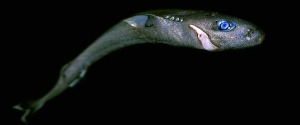SHARK ANATOMY
All creatures that live under the sea have similar functions, such as the need to breathe, reproduce, eat, and even make social contact with other members of their species, but of course they all have their own unique anatomical builds as well. Sharks for instance, may have similar structures to those of other sea worthy fish and even humans, but are equipped with special eyes, senses, gills, fins, teeth, and a skeletal structure made of all cartilage.

SKELETON:
Most other fish species have skeletons made of calcium, just like humans, but shark have a skeleton made up of cartilage that specifically helps the shark to stay afloat in the ocean since cartilage weighs a lot less than bone. Another advantage to having a cartilage skeleton is the ability for the shark to make sharper turns in smaller areas of water and can even be useful in a stronger bite since a shark keeps growing new cartilage during its whole lifetime and contributes to mineral deposits in the shark’s jaws.
EYES:
Sharks eyes consist of the same parts and functions as other fish and humans do, such as pupils, rods, cones, lenses, and retinas, but with a few differences. A shark’s eyesight has been well adapted to see within many light and dark ranges in the marine environment, this adaption has been possible due to sharks having a specialized mirror-like tissue behind the retina called the tapetum lucidum. Light hits this tissue and reflects back so that the shark can successfully navigate and hunt through dark waters. A common question amongst a lot of humans is that sharks do have eyelids, but do they ever blink? No, they don’t, because the water cleans their eyes for them. Though most sharks possess these key features, they have all diverged to different ocean environments over time, hence some sharks have protective membranes over their eyes, while others simply roll back their eyes during attacks to keep from hurting their eyes. The eye behaviors of sharks are all very unique and are more important to the function of a shark’s lifestyle than most people would think.
GILLS:
One of the most important part s of a shark! While most other fish species have only one gill slit, sharks can have up to 5 or 7 gill slits on both sides of their bodies. As the shark swims, the oxygen in the water passes over the gills and the oxygen is then absorbed into the blood stream, this is one of the main reasons why most shark species have to keep swimming in order to breathe. However, some other sharks have a gill pump, which allows them to pump water in through their mouth and out through their gills while remaining in a still position, this process can also be termed as buccal pumping, which is named for the cheek muscle that is used to undergo this type of shark breathing.
SHAPE & COLOR:
All sharks have a torpedo-shaped body that allows them to swim even faster underwater even though they have a lighter cartilage skeleton, which is also an advantage to swimming farther distances without wearing out. If you compare the shape of a shark to the shape of a DC-9 airplane, you’ll see that they are amazingly similar and built for the same purpose, and that is faster travel.
All sharks have a typical color design of a darker top side (dorsal side), and a lighter underside (ventral side), which allows sharks to participate in a type of camouflage called countershading. This camouflage trait is very useful in either hiding from a predator, or slowly stalking their prey while remaining visually unseen.
FINS & Tail:
All sharks have anal and dorsal fins which help them to swim and balance themselves within their living environments and the tail of a shark also helps to contribute to fast speed in the water. What’s interesting about these fins though is that they can pick up vibrations nearby, whether it is a distressed fish or the motor of a passing boat.
TEETH: The Most powerful jaws on the planet
Believe it or not, sharks have three to five rows of teeth, each row having a different shaped tooth. The front row consists of teeth that take a shape similar to that of a steak knife, serrated edges that rip through the flesh of the sharks prey, and the back rows have teeth shaped like needles, which pose to help keep the prey within the shark’s mouth while attacking. These are a common shape found in most shark teeth, but on the occasion due to environmental differences and diet, the teeth of a shark may have only one single shape. Unlike most other animal jaws, both the upper and lower jaws of a shark move, leading to the advantage of grasping its prey first with the lower jaw, and then with the second only to then toss its head back and forth to rip away a bite of the prey and swallow it whole. Sharks never run out of teeth and can have up to 20,000 teeth in their lifetime.















